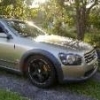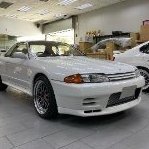M35 Stagea intake suction pipe
Announcements
-
Similar Content
-
Latest Posts
-
Given you already have the engine cross member to match and likely gearbox mount to. The SR20 has a head start on the RB in this case. They handle GREAT with an SR20, lots of fun. One I did back in the day
-
have no doubt and wanted too trust me and may regret later not necessarily worried about weight (would be 8 kg ish total) it was more the $$ to do it properly is about $6 - $7K in hardwear need long 310mm stroke jacks etc - plus install and call me whatever im not doing it myself even if wanted too cant weld etc - thats $10K installed vs fraction of that cost while Ive spent some money on this POS I actually really dont like doing so unless its got a large chance to make me go faster 😁 hey in still carting this things around on a 15 yr old rusted open trailer so I can spend on racing not buy a new trailer to look better the manual jacks Ive had done are heavy and take space but are transportable and usable anywhere - taking or organizing even compressed air let alone nitrogen which is more whats needed coming from Perth to Winton or Sydney or the like honestly just adds to my brain headaches/ hurts of organisation also ha 15 mins job will get down to 2 - 5 min job vs 1 min job for airjacks - all tradeoffs I spose
-
By soviet_merlin · Posted
Purely out of curiosity, how do you know all this @dbm7? Do you work with automatic gearboxes professionally? This goes way way way beyond "I've had an automatic Skyline once and did some mucking around" -
I'll just reiterate that it's best to do all the wiring diagnostics, before even thinking about buying replacement solenoids ~ that is, be absolutely sure the solenoid is bad.....ie; bad connector(s), rodents chewed through a wire, etc etc. If you don't so this, you can fork out all the money for solenoids, only to find something else is wrong (this'll make you cry if you pull the valvebody only to find a broken wire is at fault... ...some more glue on the solenoid packs -- this is the RE5R01A shift solenoid assembly.... ...these are all shift solenoids ~ ostensibly they're the same as the shift solenoids from the 4-speed auto.... ...this is the RE4R01A solenoid set... ...with these, you have 3 shift solenoids attached to the plate, and the separate solenoid is the EPC solenoid (line pressure control) -- with both designs, the TC lockup clutch solenoid (also PWM so they could slide the clutch shut), is located on the lower valvebody half.... ...(story time)...back in the 90's, it was a common fault that the EPC solenoid (or TC-lock solenoid) would fail, but Nissan only sold them as part of the assembly (think ~$350 at the time) ~ thing was, Isuzu also used these boxes in light commercials, and you could buy the PWM solenoid as a separate part, so it was possible to buy/use that solenoid (around $65), and make it fit (remove the circlip, fit to old plate and deal with wiring)...making it a more cost effective repair. I've not seen the RE5R01A shift solenoid assembly, but with the 4-speed RE4R01A it was possible to hack/fit a single shift solenoid onto an other working set, using a donor solenoid from another set with failed EPC....(by rights the whole set should be replaced), but it ends up being a question of how much life is left in the box itself ; sometimes it's a viable repair to fix one solenoid, just to get another 100k of road miles out of it before it needs first overhaul...other times the box is that old/worn, you're as well doing first overhaul and replacing the solenoids and starting fresh... What Nissan did here with the 5-speed, was relocate the EPC solenoid to the lower valvebody (next to the TC lockup solenoid), and stuck the direct-drive clutch solenoid (for the extra gear) where the EPC solenoid used to be on the 4-speed....I can only imagine they did this for serviceability ; the PWM solenoids are most likely to fail, and it's a doddle to drop the pan and change these out (as opposed to dropping the valvebody itself to get at a top mounted EPC)... ...also keep in mind, that some BMW 3/5 series & Mazda (and maybe some Ford/Mazda rebadges, not sure), also used the RE5R01A box under a different name/part number...not saying parts availability is any better, but sometimes it helps to know this when it comes to NOS floating about in the EU.... HTH
-
FWIW, air jacks are actually pretty light and simple to add, they are just 4 hydraulic cylinders (often at the main cage A and C pillar points) and an externally accessible airline - they make quick work a breeze
-









Recommended Posts
Create an account or sign in to comment
You need to be a member in order to leave a comment
Create an account
Sign up for a new account in our community. It's easy!
Register a new accountSign in
Already have an account? Sign in here.
Sign In Now